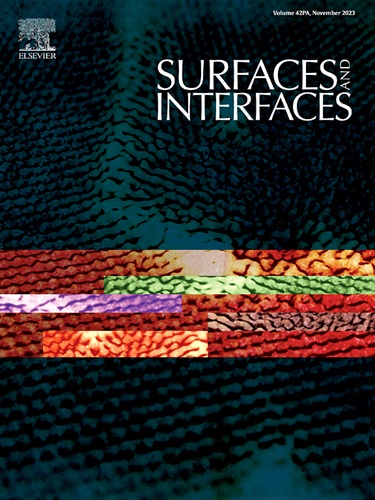BiOI-Sm2O3 nanocomposites on translucent porous polymer for visible-light decontamination of antibiotic wastewater
IF 5.7
2区 材料科学
Q2 CHEMISTRY, PHYSICAL
引用次数: 0
Abstract
Efficient removal of pharmaceutical pollutants from water resources remains a challenge for ensuring eco-sustainability. Herein, we report a unique BiOI-Sm2O3 heterojunction nanocomposite (NC) for dissipating persistent pharmaceutical pollutants. The uniqueness of this work arises from the fabrication of a visible-light-responsive reusable/durable photocatalyst by uniformly dispersing BiOI-Sm2O3 (BS) NCs across a translucent macro-/meso-porous poly(EDGMA) monolith (PEM). From different ratios of BS NCs, the choice of BS-15, i.e.,(15 %)BiOI-(85 %)Sm2O3 showed brilliant visible-light photocatalysis for dissipating enrofloxacin (ENF) drug residues that remain persistent in environmental sources. The uniform dispersion of BS-15 NC across the monolithic template generated a renewable BS-15 PEM photocatalyst with superior surface and structural properties. The surface, structural, and porosity features of the BS NCs and BS-15 PEM photocatalyst were characterized using p-XRD, XPS, FE-SEM-EDX, HR-TEM-SAED, FT-IR, UV-Vis-DRS, PLS, EIS, and BET/BJH analysis. The inorganic-organic hybrid photocatalyst exhibited superior visible-light photocatalytic activity due to optimal energy band gap narrowing and greater surface area and porosity, facilitating faster diffusion and voluminous pollutant sorption for eVentual photocatalytic degradation. The optimization of the experimental parameters revealed a solution pH of 3.0, a photocatalyst dosage of 75 mg, an ENF concentration of 15 mg/L, H2O2 (oxidizer) of 1.0 mM, and a tungsten filament lamp of 150 W/cm2, which were adequate for the dissipation (≥99.5 %) of ENF within 20 min of photocatalysis. The drug degradation pathways were analyzed using HR-MS, and the photocatalysis mechanisms were elucidated using EPR and VB-XPS analysis. The photocatalyst's excellent stability and photocatalytic efficiency offered a cost-effective solution for wastewater treatment.

半透明多孔聚合物上的biio - sm2o3纳米复合材料用于抗生素废水的可见光去污
有效地从水资源中去除药物污染物仍然是确保生态可持续性的一个挑战。在此,我们报道了一种独特的BiOI-Sm2O3异质结纳米复合材料(NC),用于消散持久性药物污染物。这项工作的独特之处在于,通过将BiOI-Sm2O3 (BS) NCs均匀分散在半透明的宏/介孔聚(EDGMA)单体(PEM)上,制造了一种可见光响应的可重复使用/耐用光催化剂。从不同配比的BS NCs中,选择BS-15,即(15%)BiOI-(85%)Sm2O3,对环境源中残留的恩诺沙星(ENF)药物残留具有良好的可见光催化作用。BS-15 NC均匀分散在单片模板上,生成了具有优异表面和结构性能的可再生BS-15 PEM光催化剂。采用p-XRD、XPS、FE-SEM-EDX、HR-TEM-SAED、FT-IR、UV-Vis-DRS、PLS、EIS和BET/BJH等分析手段表征了BS NCs和BS-15 PEM光催化剂的表面、结构和孔隙特征。该无机-有机杂化光催化剂由于能隙缩小、比表面积和孔隙度增大而具有优异的可见光催化活性,有利于更快的扩散和大量的污染物吸附,从而实现最终的光催化降解。优化后的实验参数为:溶液pH为3.0,光催化剂用量为75 mg, ENF浓度为15 mg/L, H2O2(氧化剂)用量为1.0 mM,钨丝灯功率为150 W/cm2,可使ENF在光催化20 min内耗散(≥99.5%)。采用HR-MS分析药物降解途径,EPR和VB-XPS分析阐明光催化机制。该光催化剂具有优异的稳定性和光催化效率,为废水处理提供了一种经济有效的解决方案。
本文章由计算机程序翻译,如有差异,请以英文原文为准。
求助全文
约1分钟内获得全文
求助全文
来源期刊

Surfaces and Interfaces
Chemistry-General Chemistry
CiteScore
8.50
自引率
6.50%
发文量
753
审稿时长
35 days
期刊介绍:
The aim of the journal is to provide a respectful outlet for ''sound science'' papers in all research areas on surfaces and interfaces. We define sound science papers as papers that describe new and well-executed research, but that do not necessarily provide brand new insights or are merely a description of research results.
Surfaces and Interfaces publishes research papers in all fields of surface science which may not always find the right home on first submission to our Elsevier sister journals (Applied Surface, Surface and Coatings Technology, Thin Solid Films)
 求助内容:
求助内容: 应助结果提醒方式:
应助结果提醒方式:


